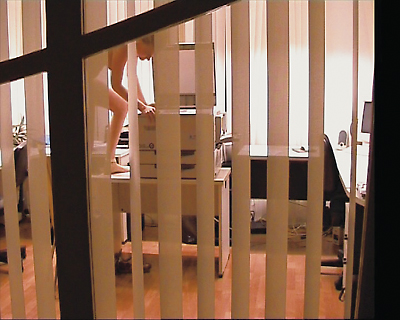| Zeitschrift Umělec 2003/2 >> Pap friction | Übersicht aller Ausgaben | ||||||||||||
|
|||||||||||||
Pap frictionZeitschrift Umělec 2003/201.02.2003 Jeffrey A. Buehler | geschichte | en cs |
|||||||||||||
|
Prague’s Gallery Art Factory came swooping onto the Czech scene from Slovakia last year, unapologetically landing right on Wenceslas Square in a dark industrial box that used to house a large printing factory. With great spirit the walls were painted various hues of a dark red and the space comfortably outfitted with black designer leather couches and chairs. Walking in, one would be hard pressed to even call it a gallery. Interior decoration meets art weirdness. Which, according to owner Dr. Zora Carrier, one half of Factory’s team, is a big part of the point.
Carrier sits and chats while she fiddles with a computer to show me the videos featured in the gallery’s latest show, PAL Fiction: “With artists working with new media … the old ways of showing art are no longer relevant,” she says. “I mean, come on, the white walls were chosen by the impressionists and we still use them today, even though the media the artists use have completely changed.” I look at the walls from my comfy chair, plastic glass of water in hand, and I had to admit that the stills from the short videos by Czech and Slovak artists looked good on the deep red… But my gut told me there was something fishy about it. It’s still a color, and therefore a context. Why make a point of it? Apparently Michal Pěchoček, one of the artists featured in the program, had similar reservations as he chose to paint the wall behind his sequence of tram images from his video Neobvyklé Rukojmí (Unusual Hostages) back to a “traditional” white. Dr. Carrier eagerly points out the Gallery’s flexibility in allowing this to happen. Indeed, controlled chemical mixtures seem to be on the agenda and an integral part of the Factory experience. The gallery is known for its practical moneymaking skills, for cultivating business relationships, and for using the space in various ways to put the bread on the table. Dr. Carrier has no qualms about saying the gallery’s main source of income was never meant to come from art sales. The result: on opening night, a sticky summer brew of business types, artists, and art scene regulars mix in an awkward dance of suspicion and goodwill, plastic shot glasses of slivovice and tepid bottled water in hand, the artists themselves on display, playing the role of circus sideshow freaks. “The bankers in suits want to see David Černý take off his shirt and Jiří David come in with blue hair. That’s what they’re here to see,” my gracious host offers, just before double clicking on our first video. They obviously weren’t there to see the art, as one source informed me that “technical difficulties” delayed the projections for so long that, by the time the videos were actually shown, nearly every visitor had fled inferno Art Factory for the cooler night air. I settle back into my chair. I am alone, so I have my choice of what I want to see. Anyway, that’s how this show works. A handful of people gathers every evening at seven in the evening and choose what they want to watch, so I feel in tune with the show’s premise. We view several excellent videos together, most of them Slovak. Let’s see: On the menu were sassy Anetta Mon Chisa’s art happenings and sad but sweet Vladimíra Pčolova. Chisa strips behind hanging slat drapes in an empty office with a photocopier on a table. Once naked, she proceeds to hunch over the copier and Xerox her genitals. The Czech entree includes the sublime Marek Ther, and Michal Pěchouček. Most of the artists are mainstays of the active art scenes both here and in Bratislava. The videos collected all tell a story of some kind and in general are accessible. In total there are ten Czech and 16 Slovak artists in the show. Curator Martin Dostál did a fine job of putting together a wide and deep collection of videos that shows the various dimensions of what video artists are doing in these countries, especially Slovakia. And with Dr. Carrier as an amiable and garrulous guide, the afternoon is hardly a waste. However, down to the practical aspects of putting on a show, everything about the gallery is sloppy style over delivering the goods. The art group Podebal’s image on the wall of Havel shaking hands with Fidel Castro catches my eye and I ask to see the video. Dr. Carrier, with a charming but sheepish look on her face, explains that the group has neglected to bring in their video. After nearly one year, the Factory’s advertised web site still displays the one now laughably ironic page: Opening Soon. Gallery Art Factory - It Works! The PAL Fiction exhibition brochure, printed on expensive paper, is too garbled to read in English, to wit: “On the contrary, at careless time of sun stilling, it intents to pull in to suggestive and emotive video-world, caught and out - generated by the top of Czech and Slovak artists, during the last ten years.” Which maybe sums it up best. But this shouldn’t stop you from popping in to check out Art Factory’s latest incarnation, however wildly spangled in disjointed good intentions it is, you just might even get a glass of something warm to drink.
01.02.2003
Empfohlene Artikel
|
|||||||||||||











Kommentar
Der Artikel ist bisher nicht kommentiert wordenNeuen Kommentar einfügen